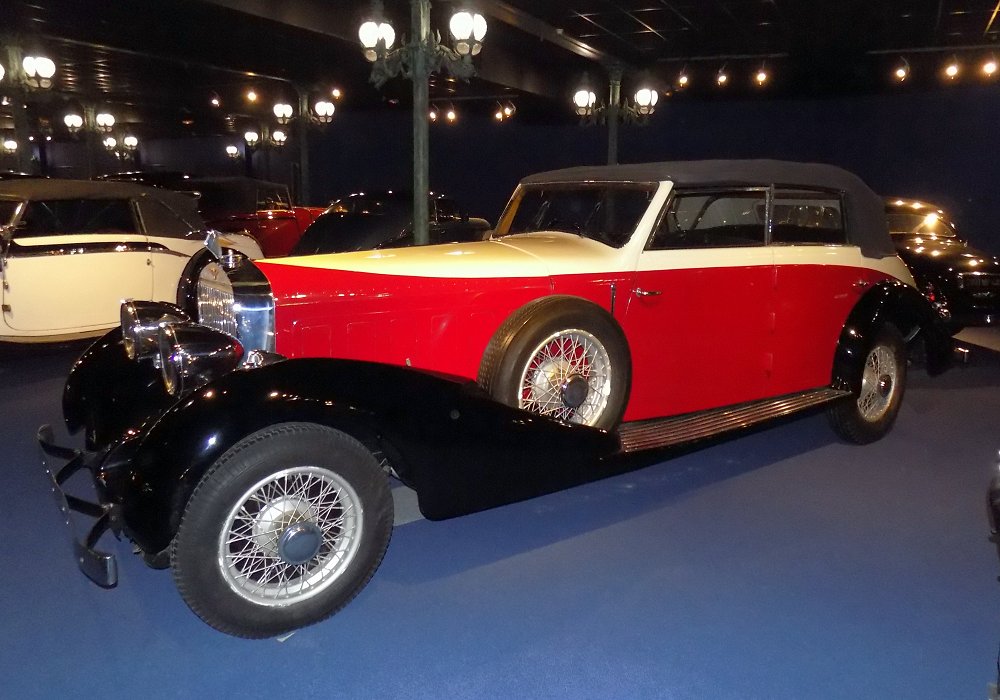Description
The Hispano-Suiza J12 Cabriolet was one of the grandest and most technically refined automobiles of the prewar era, a car that stood at the absolute pinnacle of luxury and engineering in the 1930s. Introduced in 1931 as the successor to the H6 series, the J12 was a masterpiece of precision, elegance, and power—crafted for the most discerning clientele in Europe and beyond. The Cabriolet version, in particular, combined the majestic presence of a limousine with the open-air glamour of a grand touring car, becoming one of the most desirable body styles ever fitted to the J12 chassis.
The heart of the J12 was its remarkable V12 engine, designed by Marc Birkigt, the Swiss-born engineer who had been responsible for Hispano-Suiza’s legendary aircraft engines during World War I. The J12’s engine was an all-aluminum 60-degree V12 displacing 9.4 litres (and later 11.3 litres in some models), with a single overhead camshaft per bank. Each block was machined from a solid billet of aluminum—a costly and complex process that demonstrated Hispano-Suiza’s uncompromising approach to engineering. The result was an engine of exceptional smoothness, reliability, and silence. Producing around 220 horsepower, it propelled the car with effortless grace, allowing for a top speed of approximately 160 km/h (100 mph)—an astonishing figure for a luxury automobile weighing more than two tons.
The J12’s chassis was equally sophisticated. It was built for comfort, strength, and precision handling, with carefully balanced suspension and servo-assisted four-wheel brakes, an innovation Hispano-Suiza had pioneered in the 1920s. The car’s ride quality and composure at speed were unmatched, and its steering, while heavy at low speeds, offered remarkable accuracy once underway. The entire vehicle exuded a sense of mechanical perfection that even Rolls-Royce and Bentley struggled to equal.
The Cabriolet version of the J12 was most often bodied by France’s leading coachbuilders, each bringing their own artistic interpretation to the car’s majestic proportions. Firms such as Saoutchik, Vanvooren, Kellner, and Henri Chapron created open-top masterpieces that balanced grandeur with grace. These cabriolets typically featured long, sweeping fenders, a low, elegant roofline, and subtle chrome accents that highlighted the car’s stately form. When the top was lowered, the J12 transformed into an open tourer of immense presence—a car that seemed equally at home on the boulevards of Paris or the coastal roads of the Côte d’Azur.
Inside, the Hispano-Suiza J12 Cabriolet was a triumph of craftsmanship. The cabin was finished with the finest materials available—hand-stitched leather, polished wood veneers, and machined metal fittings of jewelry-like precision. Every detail, from the switchgear to the door handles, reflected a standard of artistry that bordered on perfectionism. Passengers were insulated from vibration and noise to an extraordinary degree, and the driving experience was defined by a serene, almost effortless smoothness.
Driving the J12 Cabriolet was a revelation. The vast V12 engine delivered immense torque at low revs, allowing the car to glide forward with near silence. Acceleration was steady but commanding, and the servo-assisted brakes provided confidence and control uncommon in large luxury cars of the period. The J12 was often praised for its ability to combine the comfort of a limousine with the performance and balance of a grand touring machine—a duality that few other marques could achieve.
Production of the Hispano-Suiza J12 was limited, with only around 120 chassis built between 1931 and 1938, making each example a rare and highly individual creation. The Cabriolet versions were among the most exclusive, often ordered by royalty, industrialists, and heads of state. The car’s price was extraordinarily high—well above that of a Rolls-Royce Phantom II—ensuring that it remained accessible only to the world’s elite.
Today, the Hispano-Suiza J12 Cabriolet is regarded as one of the greatest achievements in automotive history. It represents the zenith of Hispano-Suiza’s craftsmanship and engineering philosophy—a car built not merely for transport, but as a work of mechanical art. To see one today is to witness an era when technology, luxury, and beauty were fused into a singular expression of excellence. The J12 Cabriolet remains a timeless symbol of prewar grandeur and one of the most magnificent automobiles ever created.
